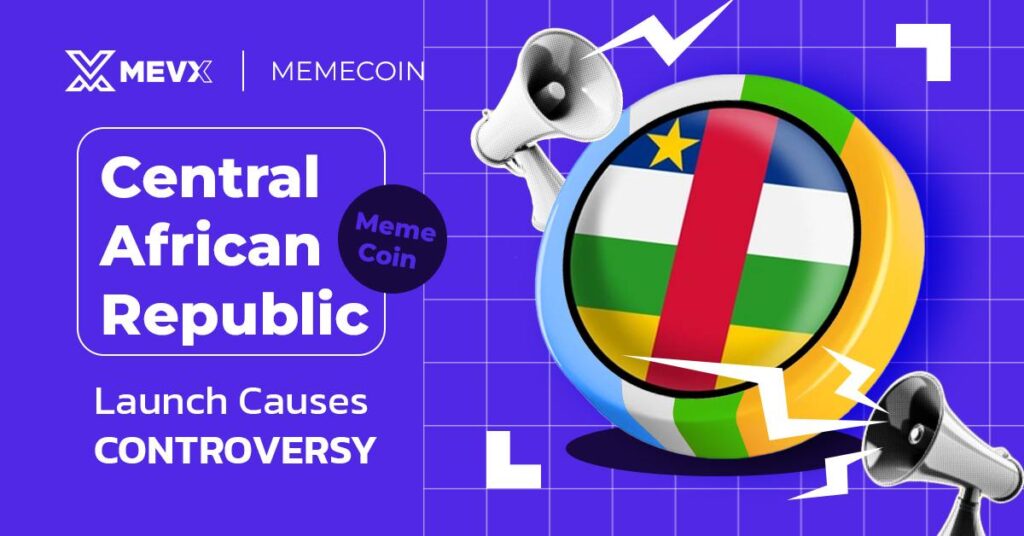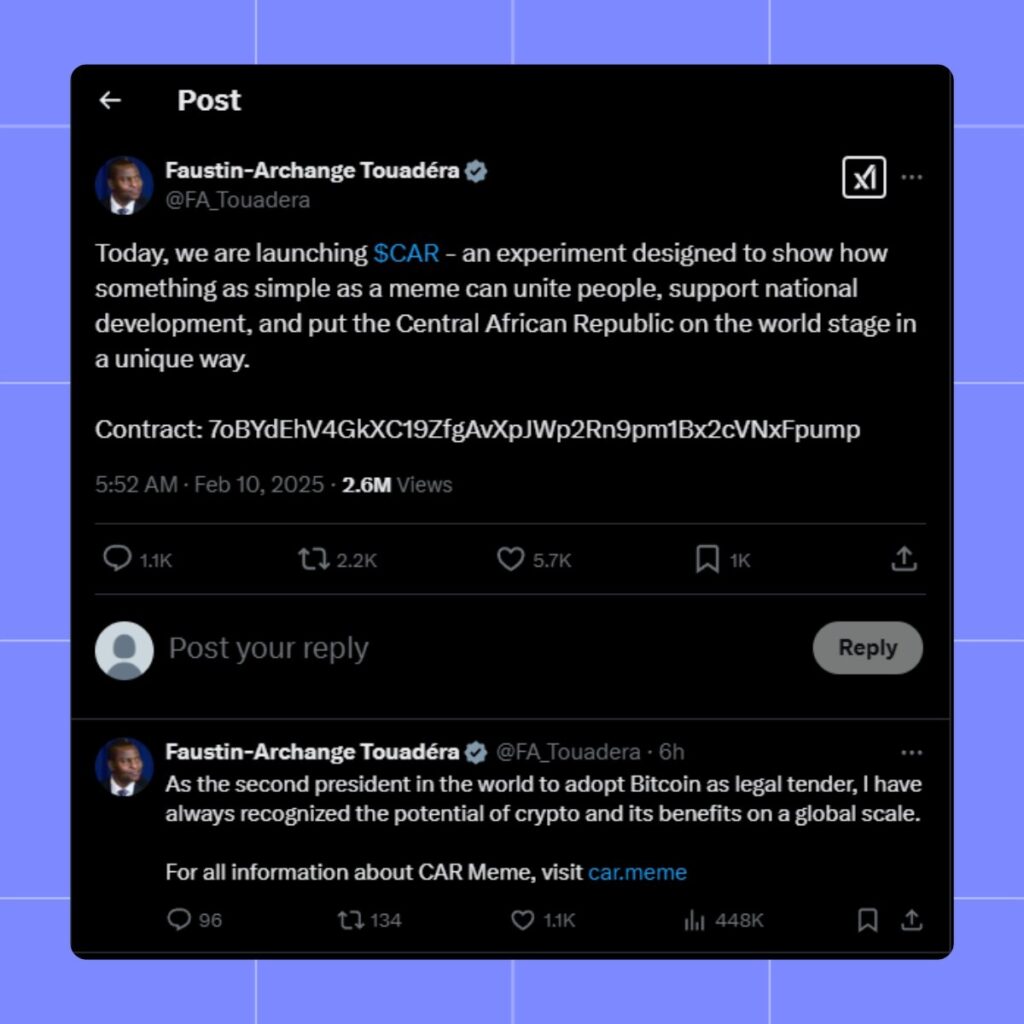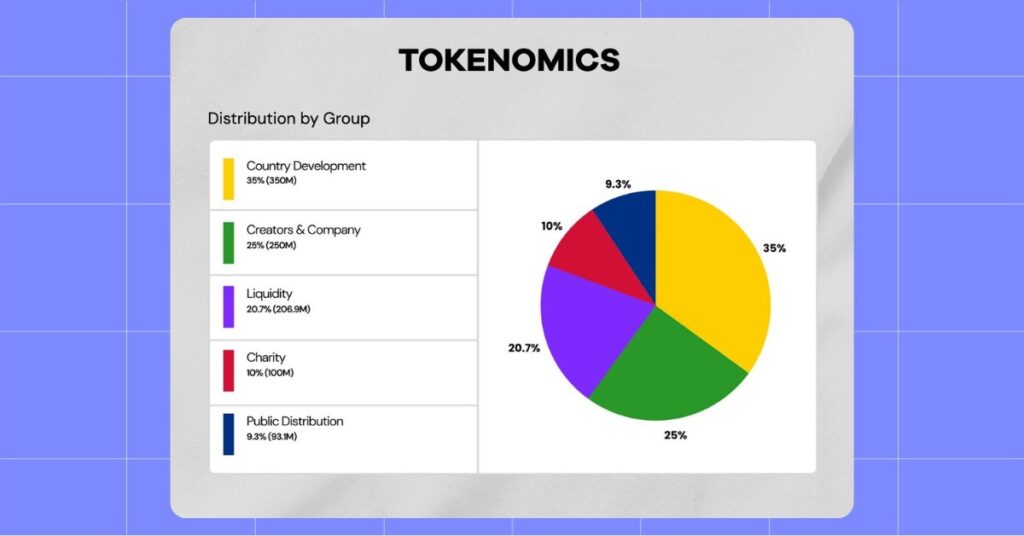On February 9, 2025, the Central African Republic’s (CAR) president, Faustin-Archange Touadéra, made a shocking proclamation about the release of an official meme coin on the Solana blockchain. His announcement wowed enthusiasts in the world of cryptocurrency. However, it raised eyebrows about its authenticity. As people can now guess, is this an authentic blockchain adoption experiment, or is this a highly complex fraud masquerading as an experiment? In this article, we will provide detailed background on the Central African Republic Meme Coin.

Context and Announcement of Central African Republic Meme
CAR’s dealings with cryptocurrency have been quite intricate. It is one of the few countries that tried to adopt digital assets on a national level. In April 2022, its government made Bitcoin a legal currency for a short period of time, making it the second country after El Salvador to adopt cryptocurrency. Nevertheless, the policy was changed in less than a year’s time due to pressure from other countries and concerns from regional economic institutions.
This serves as an additional effort to step into the crypto world, albeit from an unconventional angle. According to the statement, the purpose of the launch was to “explore” the direction of national development and put CAR on the global map.

Tokenomics of Central African Republic Meme Coin
- Date of Launch: February 9, 2025
- Blockchain: Solana
- Launch Platform: Pump.fun
- Token Name: Central African Republic Meme
- Total Supply: 1,000,000,000
- Trading Volume: $445 million
- Current Market Cap: $556 million
- All-Time High (ATH): $0.89 per token
- Current Price: $0.5273
- Contract Address: 7oBYdEhV4GkXC19ZfgAvXpJWp2Rn9pm1Bx2cVNxFpump
Skepticism and Controversies Around Central African Republic Meme Coin
While the idea of a state-backed meme coin is intriguing, many in the crypto community remain skeptical. Several red flags have emerged, leading some to believe that the announcement may not have come from the president himself.
Deepfake Concerns

One of the most concerning aspects of the announcement is that at least two AI deepfake detection tools have flagged President Touadéra’s video as potentially manipulated. Deepware, an AI-powered deepfake detection tool, assigned an 82% probability that the video is AI-generated. Other tools, such as Avatrify and Deepware’s secondary checker, failed to pick up on any manipulation, leading to conflicting reports.
If the video is indeed a deepfake, it raises serious concerns about whether the announcement was made by the real President Touadéra or if his account was hacked.
Legitimacy of the Announcement
Several inconsistencies in the announcement have fueled suspicions:
- The tweet was written entirely in English, while French is the official language of CAR.
- The timing of the announcement—made at midnight local time—seemed unusual for an official government statement.
- The language and phrasing used in the post did not match the formal tone expected from a national leader.
- The official X account for the meme coin (@Carmeme_news) was swiftly suspended, adding to concerns about its authenticity.
Possible Hacking Incident?
Another theory suggests that the president’s X account may have been compromised, with hackers using it to launch a fraudulent cryptocurrency. Given the recent wave of high-profile social media hacks—including those of former Malaysian Prime Minister and the Solana-based decentralized exchange Jupiter—this possibility cannot be ruled out.
To make matters worse, the official domain of the CAR meme coin was registered only three days prior to the launch on Namecheap, a domain registrar popular among individuals as opposed to governments. Namecheap has since suspended the services of the domain, adding to the speculation about the project’s validity.
The Broader Economic and Political Context
CAR’s History with Crypto
The Central African Republic has tried before to use cryptocurrency to bring in investment. In 2022, it launched Sango Coin, a government-issued token designed to provide tokenized citizenship to investors. The initiative did not catch on and was dropped quietly.
Despite this failure, CAR is still one of the poorest countries on earth, with a GDP of only $2.56 billion. With its economic challenges, some think that issuing a meme coin could be an innovative, if dangerous, method of bringing foreign investment into the country.
Potential Implications of a State-Backed Meme Coin
If legitimate, the CAR Meme Coin would be a precedent for national cryptocurrencies outside of stablecoins or central bank digital currencies (CBDCs). It would be the first time a sovereign nation has adopted a highly speculative, community-led financial instrument as a part of its economic policy.
That being said, the extremely volatile nature of meme coins makes this a very dangerous undertaking. If the government were to sanction it officially, CAR might find itself under intense regulatory pressure from international organizations and financial institutions.
Beyond regulatory concerns, the success of meme coins also depends on community support and cultural relevance. Without ongoing support, the CAR Meme Coin might rapidly lose steam and disappear into the background, leaving investors with considerable losses.
Market Performance and Token Distribution of Central African Republic Meme
Despite the skepticism, the CAR Meme Coin has performed remarkably well in its first days of trading. Within hours of its launch, it reached a market capitalization of $527 million, with a trading volume of $445 million. It later peaked at an all-time high of $0.89 per token, though prices have since stabilized around $0.5273.
Token Distribution
According to blockchain explorers such as Solscan, the token’s distribution appears to match the figures published on its official website:

- 33.31% of supply is held in one wallet
- 25% of supply is held in another wallet
- 9.81% and 8.39% of supply are held in two additional wallets, with one of them possibly earmarked for charity
- 20% of supply, promised for liquidity, has yet to be added to any trading pool
This lack of liquidity allocation raises concerns that the project could be subject to rug-pull risks, where developers drain funds and abandon the token.
Additionally, the fact that such a large percentage of tokens are concentrated in a few wallets raises further red flags about potential market manipulation.
Conclusion: Is This the Future of National Crypto Adoption or a Major Scam?
The Central African Republic’s meme coin launch has indeed made global headlines. If it is true, it could be a new wave of government blockchain adoption with a twist. But the numerous red flags—from deepfake allegations and social media account suspensions to suspicious tokenomics—make it difficult to believe the project at face value.
For the time being, investors should exercise extreme caution with the CAR Meme Coin. There is a chance to make a profit, however, there is a potential to lose just as much. At the moment, the involvement of President Touadéra is throwing us off as it is difficult to tell if this is the actual state-backed project or possibly one of the most sophisticated crypto scams in history.
To get updated on the meme coin markets, follow MevX Blog!
Share on Social Media:
